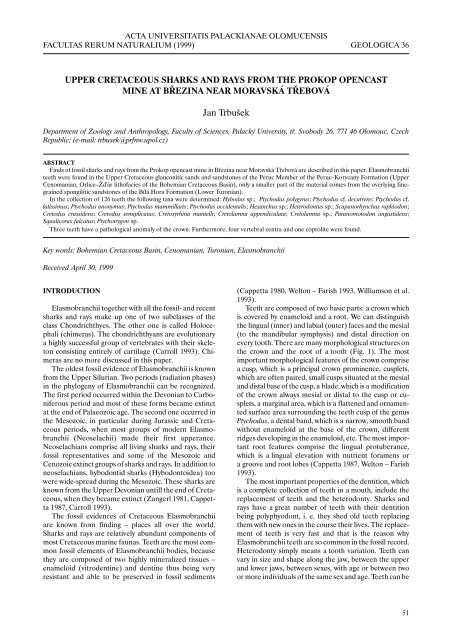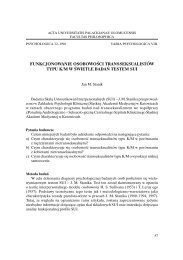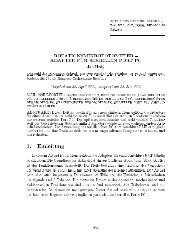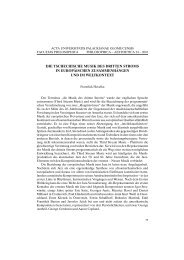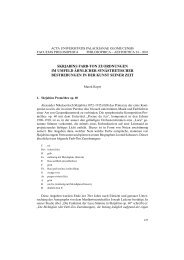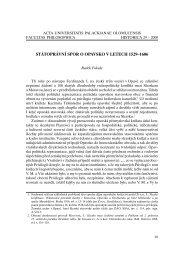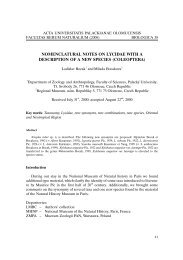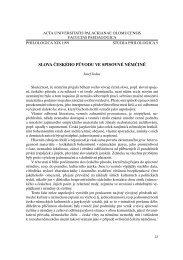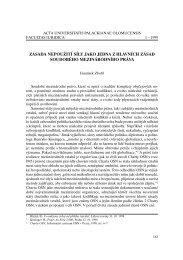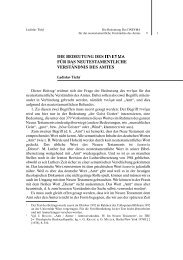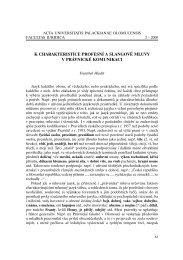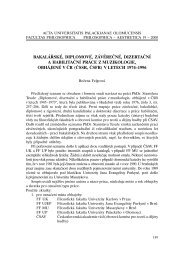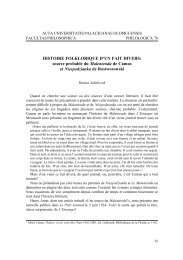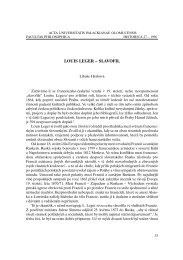UPPER CRETACEOUS SHARKS AND RAYS FROM THE PROKOP ...
UPPER CRETACEOUS SHARKS AND RAYS FROM THE PROKOP ...
UPPER CRETACEOUS SHARKS AND RAYS FROM THE PROKOP ...
Create successful ePaper yourself
Turn your PDF publications into a flip-book with our unique Google optimized e-Paper software.
ACTA UNIVERSITATIS PALACKIANAE OLOMUCENSIS<br />
FACULTAS RERUM NATURALIUM (1999) GEOLOGICA 36<br />
<strong>UPPER</strong> <strong>CRETACEOUS</strong> <strong>SHARKS</strong> <strong>AND</strong> <strong>RAYS</strong> <strong>FROM</strong> <strong>THE</strong> <strong>PROKOP</strong> OPENCAST<br />
MINE AT BŘEZINA NEAR MORAVSKÁ TŘEBOVÁ<br />
INTRODUCTION<br />
Elasmobranchii together with all the fossil- and recent<br />
sharks and rays make up one of two subclasses of the<br />
class Chondrichthyes. The other one is called Holocephali<br />
(chimeras). The chondrichthyans are evolutionary<br />
a highly successful group of vertebrates with their skeleton<br />
consisting entirely of cartilage (Carroll 1993). Chimeras<br />
are no more discussed in this paper.<br />
The oldest fossil evidence of Elasmobranchii is known<br />
from the Upper Silurian. Two periods (radiation phases)<br />
in the phylogeny of Elasmobranchii can be recognized.<br />
The first period occurred within the Devonian to Carboniferous<br />
period and most of these forms became extinct<br />
at the end of Palaeozoic age. The second one occurred in<br />
the Mesozoic, in particular during Jurassic and Cretaceous<br />
periods, when most groups of modern Elasmobranchii<br />
(Neoselachii) made their first apperance.<br />
Neoselachians comprise all living sharks and rays, their<br />
fossil representatives and some of the Mesozoic and<br />
Cenozoic extinct groups of sharks and rays. In addition to<br />
neoselachians, hybodontid sharks (Hybodontoidea) too<br />
were wide-spread during the Mesozoic. These sharks are<br />
known from the Upper Devonian untill the end of Cretaceous,<br />
when they became extinct (Zangerl 1981, Cappetta<br />
1987, Carroll 1993).<br />
The fossil evidences of Cretaceous Elasmobranchii<br />
are known from finding – places all over the world.<br />
Sharks and rays are relatively abundant components of<br />
most Cretaceous marine faunas. Teeth are the most common<br />
fossil elements of Elasmobranchii bodies, because<br />
they are composed of two highly mineralized tissues –<br />
enameloid (vitrodentine) and dentine thus being very<br />
resistant and able to be preserved in fossil sediments<br />
Jan Trbušek<br />
Department of Zoology and Anthropology, Faculty of Sciences, Palacký University, tř. Svobody 26, 771 46 Olomouc, Czech<br />
Republic; (e-mail: trbusek@prfnw.upol.cz)<br />
ABSTRACT<br />
Finds of fossil sharks and rays from the Prokop opencast mine in Březina near Moravská Třebová are described in this paper. Elasmobranchii<br />
teeth were found in the Upper Cretaceous glauconitic sands and sandstones of the Peruc Member of the Peruc–Korycany Formation (Upper<br />
Cenomanian, Orlice–Žár lithofacies of the Bohemian Cretaceous Basin), only a smaller part of the material comes from the overlying finegrained<br />
spongilitic sandstones of the Bílá Hora Formation (Lower Turonian).<br />
In the collection of 126 teeth the following taxa were determined: Hybodus sp.; Ptychodus polygyrus; Ptychodus cf. decurrens; Ptychodus cf.<br />
latissimus; Ptychodus anonymus; Ptychodus mammillaris; Ptychodus occidentalis; Hexanchus sp.; Heterodontus sp.; Scapanorhynchus raphiodon;<br />
Cretodus crassidens; Cretodus semiplicatus; Cretoxyrhina mantelli; Cretolamna appendiculata; Cretolamna sp.; Paranomotodon angustidens;<br />
Squalicorax falcatus; Ptychotrygon sp.<br />
Three teeth have a pathological anomaly of the crown. Furthermore, four vertebral centra and one coprolite were found.<br />
Key words: Bohemian Cretaceous Basin, Cenomanian, Turonian, Elasmobranchii<br />
Received April 30, 1999<br />
(Cappetta 1980, Welton – Farish 1993, Williamson et al.<br />
1993).<br />
Teeth are composed of two basic parts: a crown which<br />
is covered by enameloid and a root. We can distinguish<br />
the lingual (inner) and labial (outer) faces and the mesial<br />
(to the mandibular symphysis) and distal direction on<br />
every tooth. There are many morphological structures on<br />
the crown and the root of a tooth (Fig. 1). The most<br />
important morphological features of the crown comprise<br />
a cusp, which is a principal crown prominence, cusplets,<br />
which are often paired, small cusps situated at the mesial<br />
and distal base of the cusp, a blade, which is a modification<br />
of the crown always mesial or distal to the cusp or cusplets,<br />
a marginal area, which is a flattened and ornamented<br />
surface area surrounding the teeth cusp of the genus<br />
Ptychodus, a dental band, which is a narrow, smooth band<br />
without enameloid at the base of the crown, different<br />
ridges developing in the enameloid, etc. The most important<br />
root features comprise the lingual protuberance,<br />
which is a lingual elevation with nutrient foramens or<br />
a groove and root lobes (Cappetta 1987, Welton – Farish<br />
1993).<br />
The most important properties of the dentition, which<br />
is a complete collection of teeth in a mouth, include the<br />
replacement of teeth and the heterodonty. Sharks and<br />
rays have a great number of teeth with their dentition<br />
being polyphyodont, i. e. they shed old teeth replacing<br />
them with new ones in the course their lives. The replacement<br />
of teeth is very fast and that is the reason why<br />
Elasmobranchii teeth are so common in the fossil record.<br />
Heterodonty simply means a tooth variation. Teeth can<br />
vary in size and shape along the jaw, between the upper<br />
and lower jaws, between sexes, with age or between two<br />
or more individuals of the same sex and age. Teeth can be<br />
51
Fig. 1: The most important morphological features of the Elasmobranchii<br />
teeth (Cappetta 1987).<br />
subdivided into groups based on the tooth size, shape<br />
and position relative to the mandibular (jaw) symphysis.<br />
We can distinguish symphysial (parasymphysial), anterior,<br />
lateral, anterolateral and posterior teeth (Cappetta<br />
1987, Carroll 1993, Welton – Farish 1993).<br />
In addition to the teeth, other body- and trace fossils<br />
of Cretaceous Elasmobranchii are being found: placoid<br />
scales, fin spines, vertebrae, parts of calcified cartilage,<br />
complete skeletons with prints of soft tissues, coprolites<br />
(fossilized excrements), enterospirae (fossilized intestines),<br />
resting and feeding traces etc (Zangerl 1981, Cappetta<br />
1987, Welton – Farish 1993).<br />
Fossil sharks and rays are relatively common in marine<br />
sediments of the Bohemian Cretaceous Basin. The<br />
first authors, to describe the Cenomanian, Turonian and<br />
Senonian Elasmobranchii faunas found in this region,<br />
were Reuss (1845, 1846) and Frič (1878, 1879, 1885,<br />
1889, 1894, 1898, 1911). Nevertheless, since then the<br />
research on fossil Elasmobranchii stagnated in our country<br />
and no more extensive works about this group of fossil<br />
vertebrates from the Bohemian Upper Cretaceous appeared,<br />
except for several faunistic works of Zahálka<br />
(1931), Adamovič (1987, 1994), Vlačiha (1996) and Trbušek<br />
(1998). Most mentions of fossil Elasmobranchii confine<br />
themselves to remarks on the occurence of shark<br />
teeth. Therefore there is a lack of new information about<br />
Elasmobranchii of the Bohemian Upper Cretaceous in<br />
our palaeontological literature.<br />
In this paper finds of Elasmobranchii of the Cenomanian/Turonian<br />
boundary interval in the Prokop opencast<br />
mine at Březina near Moravská Třebová are described.<br />
The research at the locality continued during the years<br />
1995–1998. The main purpose of this research is not only<br />
to provide a faunistic overview of this locality, but also to<br />
acquire new information on biology and palaeoecology<br />
of Cretaceous sharks and rays.<br />
52<br />
LOCALITY <strong>AND</strong> METHODS<br />
The Prokop opencast mine is located 1,5 km to the<br />
west of the Březina village near Moravská Třebová in<br />
Eastern Bohemia (Fig. 2).<br />
Fig. 2: Simplified map of the locality (Vachtl et al. 1968).<br />
The Upper Cretaceous sediments in the suroundings<br />
of Březina belong to the southern part of the morphologically<br />
conspicuous Hřebeč ridge. From the regionalgeological<br />
point of view these sediments belong to the<br />
Orlice–Žár lithofacies of the Bohemian Cretaceous<br />
Basin.<br />
The Cretaceous sediments in this area are resting<br />
upon strongly weathered Permian sediments of the Boskovice<br />
Furrow. The Cenomanian sedimentation started<br />
with deposition of the non-marine Peruc Member of the<br />
Peruc–Korycany Formation with conglomerates, sandstones,<br />
siltstones and claystones predominating. The overlying<br />
marine Korycany Member is mostly psammitic, being<br />
composed of poorly consolidated sandstones to unconsolidated<br />
sands rich in glauconite. These deposits are overlain<br />
by fine-grained, glauconitic, siliceous – and calcareous<br />
sandstones, sponge – spicule rich sandstones and sponge<br />
spiculites creating the lower part of the Bílá Hora Formation<br />
of Lower Turonian age (Mytiloides labiatus Zone)<br />
(Fig. 3).<br />
Geological and palaeontological conditions of the Prokop<br />
opencast mine and its close surroundings were described<br />
by Vachtl – Kopecký (1951), Soukup (1962), Vachtl<br />
et al. (1968), Vajdík et al. (1973), Konta (1982). Fossil<br />
invertebrates only were studied in detail by Konečný<br />
(1978) and Konečný – Vašíček (1983, 1987) at this locality,<br />
but nobody studied the finds of fossil vertebrates<br />
(Chondrichthyes, Osteichthyes, Reptiles), although being<br />
relatively common here.
Fig. 3: Graphic log of lithology at the locality (Konečný 1978).<br />
1 – greyish-green coloured glauconitic sands<br />
2 – red glauconitic sands<br />
3 – dark-grey silty clays and claystones with irregular patches of<br />
glauconitic sands<br />
4 – poorly consolidated, highly glauconitic sandstones with ferruginous<br />
horizont<br />
5 – fine-grained to medium-grained glauconitic sandstones<br />
6 – fine-grained glauconitic sandstones with irregular layers of<br />
dark claystones<br />
7 – light-gray, fine-grained spongilitic sandstones<br />
Fossil remains of the sharks and rays are found especially<br />
in the glauconitic sands or in the poorly consolidated<br />
glauconitic sandstones of the marine Korycany Member<br />
(Upper Cenomanian). The remains of Elasmobranchii are<br />
very rare in the overlying fine-grained spongilitic sandstones<br />
of the Bílá Hora Formation (Lower Turonian) (Fig. 3).<br />
In most cases, the fossil remains were collected from<br />
the outer surfaces of the sandstones or by screening of<br />
the disintegrated rock materials. Most often, teeth or<br />
their fragments were found, other remains of Elasmobranchii<br />
were very rare (vertebral centra, coprolites).<br />
In most cases, isolated teeth are being found and<br />
therefore, such teeth need not to be further extracted.<br />
Only several teeth must have been separated from the<br />
rock using 8% acetic acid.<br />
All described teeth are deposited in the author’s collection.<br />
RESULTS<br />
Eighteen taxa were determined in the collection of<br />
126 teeth. The classification of fossil sharks and rays used<br />
in this paper represents a combination of many different<br />
views on the interrelationships of modern and fossil sharks<br />
and rays as summarized by Cappetta (1987) and Welton –<br />
Farish (1993).<br />
Class Chondrichthyes Huxley, 1880<br />
Subclass Elasmobranchii Bonaparte, 1838<br />
Cohort Euselachii Hay, 1902<br />
Superfamily Hybodontoidea Zangerl, 1981<br />
Family Hybodontidae Owen, 1846<br />
Genus Hybodus Agassiz, 1837<br />
Hybodus sp.<br />
(Plate I, fig. 1)<br />
Material: One posterior tooth.<br />
Description: The tooth is small, only 3 mm long and<br />
2 mm high. The crown is low with a short median cusp and<br />
well developed mesial and distal blades. Cusplets are not<br />
developed.<br />
The root is flattened.<br />
Stratigraphic occurence at the locality: This tooth was<br />
found in the glauconitic sandstones of the Korycany Member.<br />
Family Ptychodontidae Jaekel, 1898<br />
Genus Ptychodus Agassiz, 1835<br />
Ptychodus polygyrus Agassiz, 1839<br />
(Plate I, fig. 2)<br />
1839 Ptychodus polygyrus sp. n.; Agassiz, p. 156, tab.<br />
XXV, fig. 4, 5, 9, 11 (non vidi).<br />
1975 Ptychodus polygyrus Agassiz; Herman, p. 74, tab. II,<br />
fig. 12. In this work the complete synonymy is mentioned.<br />
Material: One anterolateral and one posterior tooth.<br />
Description: The dimensions of the anterolateral tooth<br />
are 14 x 17 mm. The cusp of the crown, which is slightly<br />
convex, is 9 mm high with 11 strong transverse ridges.<br />
Their distal ends terminate in concentric ridges in the<br />
marginal area, which is covered by a granular texture.<br />
The dimensions of the posterior tooth are 11 x 9 mm. The<br />
occlusal surface of the cusp, which is 6 mm high, is<br />
flattened with 8 weak transverse ridges. Their distal ends<br />
also terminate in the concentric ridges in the marginal<br />
area.<br />
The roots are lacking.<br />
Stratigraphic occurence at the locality: Both teeth were<br />
found in the glauconitic sandstones of the Korycany Member.<br />
Ptychodus cf. decurrens Agassiz, 1835<br />
(Plate I, fig. 6)<br />
1835 Ptychodus decurrens sp. n.; Agassiz, p. 54 (non vidi)<br />
1993 Ptychodus decurrens Agassiz; Williamson et al., p. 450,<br />
fig. 3.5–3.7. In this work the complete synonymy is mentioned.<br />
Material: Two anterolateral teeth.<br />
Description: The dimensions of the bigger tooth are 15 x<br />
14 mm. The low cusp of the crown, which is slightly<br />
53
convex, is 4 mm high with 9 strong transverse ridges on<br />
its occlusal surface. The ridges bifurcate on their distal<br />
ends.<br />
The root is lacking.<br />
Stratigraphic occurence at the locality: Both teeth were<br />
found in the glauconitic sandstones of the Korycany Member.<br />
Ptychodus cf. latissimus Agassiz, 1843<br />
(Plate I, fig. 5)<br />
1843 Ptychodus latissimus sp. n.; Agassiz, p. 157, tab.<br />
XXVa, fig. 1–6; tab. XXVb, fig. 24–26 (non vidi).<br />
1975 Ptychodus latissimus Agassiz; Herman, p. 67, tab. II,<br />
fig. 9. In this work the complete synonymy is mentioned.<br />
Material: One anterolateral tooth.<br />
Description: The dimensions of the tooth are 13 x 12 mm.<br />
The low cusp of the crown, which is slightly convex, is<br />
5 mm high. A part of the crown is damaged. It is a pathological<br />
anomaly, which had developed during the life of<br />
the animal and modifying the original ornament of the<br />
occlusal surface. Three very strong transverse ridges developed<br />
on the undamaged part of the crown. The fine<br />
granulated marginal area of the crown is very large.<br />
The root is lacking.<br />
Stratigraphic occurence at the locality: This tooth was<br />
found in the glauconitic sandstones of the Korycany Member.<br />
Ptychodus anonymus Williston, 1900<br />
(Plate I, fig. 7, 8, 11)<br />
1900 Ptychodus anonymus sp. n.; Williston, p. 241, tab.<br />
XXIX, fig. 5, 6, 8, 16, 18, 20, 21, 24.<br />
1975 Ptychodus mammillaris anonymus Williston; Herman,<br />
p. 58, tab. II, fig. 5.<br />
1993 Ptychodus anonymus Williston; Williamson et al., p.<br />
450.<br />
1993 Ptychodus anonymus Williston; Welton – Farish, p.<br />
57, fig. 1–7.<br />
Material: Twelve anterolateral and seven posterior teeth.<br />
Description: The dimensions of the biggest tooth found<br />
are 15 x 15 mm with the height of its crown being 10 mm.<br />
The dimensions of the smallest tooth found are 4 x 3 mm<br />
with the height of its crown being 2 mm.<br />
The crown of the anterolateral teeth has a high, conical<br />
cusp with 8–11 fine transverse ridges on its occlusal surface<br />
which is not flattened. The transition between the<br />
cusp and the marginal area is smooth, not angular.<br />
The posterior teeth have their cusp lower than the anterolateral<br />
teeth and they are asymmetrical unlike the anterolateral<br />
teeth because their cusp is moved in mesodistal<br />
direction.<br />
The roots are flattened with two weak lobes.<br />
One of the posterior teeth has a damaged crown. It is<br />
a pathological anomaly which divided the crown in two<br />
parts.<br />
Stratigraphic occurence at the locality: All teeth were<br />
found in the glauconitic sandstones of the Korycany Member.<br />
54<br />
Remarks: Ptychodus anonymus is the most common species<br />
of the genus Ptychodus found at the locality. This<br />
species is very similar to Ptychodus mammillaris. Herman<br />
(1975) considered it to be its subspecies Ptychodus mammillaris<br />
anonymus. However, I believe Ptychodus anonymus<br />
to represent an independent species.<br />
Ptychodus anonymus has not been mentioned from the<br />
Bohemian Cretaceous Basin yet.<br />
Ptychodus mammillaris Agassiz, 1835<br />
(Plate I, fig. 9, 10)<br />
1835 Ptychodus mammillaris sp. n.; Agassiz, p. 151, tab.<br />
XXVb, fig. 12–20 (non vidi)<br />
1975 Ptychodus mammillaris mammillaris Agassiz; Herman,<br />
p. 58, tab. II, fig. 4. In this work the complete<br />
synonymy is mentioned.<br />
Material: One anterolateral tooth.<br />
Description: The dimensions of the tooth are 12 x 15 mm<br />
with the height of its crown being 9 mm. This species is<br />
very similar to Ptychodus anonymus, but its tooth has<br />
a flattened occlusal surface of the cusp and the transition<br />
between the cusp to the marginal area is angular in this<br />
species. There are 9 strong transverse ridges on the cusp.<br />
The root has two large lobes.<br />
Stratigraphic occurence at the locality: This tooth was<br />
found in the glauconitic sandstones of the Korycany Member.<br />
Ptychodus occidentalis Leidy, 1868<br />
(Plate I, fig. 3, 4)<br />
1868 Ptychodus occidentalis sp. n.; Leidy, p. 205.<br />
1993 Ptychodus occidentalis Leidy; Welton – Farish, p. 64,<br />
fig. 1–3.<br />
Material: One anterolateral tooth.<br />
Description: The dimensions of the tooth are 17 x 22 mm<br />
with the height of its crown being 13 mm. It is the largest<br />
tooth of the genus Ptychodus found at the locality.<br />
The cusp of the crown is conical and very high, with 11<br />
weak transversal ridges on its occlusal surface. These<br />
ridges bifurcate in their distal ends.<br />
The fine granulated marginal area of the crown is very<br />
narrow.<br />
The root has two large lobes.<br />
Stratigraphic occurence at the locality: This tooth was<br />
found in the glauconitic sandstones of the Korycany Member.<br />
Remarks: This species is very rare and has not been<br />
mentioned from the Bohemian Cretaceous Basin yet.<br />
Subcohort Neoselachii Compagno, 1977<br />
Superorder Squalomorphii Compagno, 1973<br />
Order Hexanchiformes Buen, 1926<br />
Suborder Hexanchoidei Garman, 1913<br />
Family Hexanchidae Gray, 1851<br />
Genus Hexanchus Rafinesque, 1810
Hexanchus sp.<br />
(Plate II, fig. 1)<br />
Material: One anterolateral tooth.<br />
Description: The tooth is 6 mm long and 5 mm high.<br />
The crown has a high mesially located cusp with a distal<br />
inclination and two low cusplets, which are located more<br />
distally. The most distally located cusplet is the smallest.<br />
The root is flattened.<br />
Stratigraphic occurence at the locality: This tooth was<br />
found in the glauconitic sandstones of the Korycany Member.<br />
Superorder Galeomorphii Compagno, 1973<br />
Order Heterodontiformes Berg, 1937<br />
Family Heterodontidae Gray, 1851<br />
Genus Heterodontus Blainville, 1816<br />
Heterodontus sp.<br />
(Plate III, fig. 3)<br />
Material: One lateral tooth.<br />
Description: The tooth is 8 mm long an 4 mm wide. It is<br />
elongated in mesodistal direction .<br />
The crown is flat and ornamented. Its occlusal surface<br />
has a longitudinal ridge in its middle part, from which<br />
smaller ridges extend at right angles.<br />
The root is lacking.<br />
Stratigraphic occurence at the locality: This tooth was<br />
found in the glauconitic sandstones of the Korycany Member.<br />
Order Lamniformes Berg, 1958<br />
Family Mitsukurinidae Jordan, 1898<br />
Genus Scapanorhynchus Woodward, 1889<br />
Scapanorhynchus raphiodon (Agassiz, 1843)<br />
(Plate II, fig. 3–6)<br />
1843 Lamna raphiodon sp. n.; Agassiz, p. 296, tab. XXXVIIa,<br />
fig. 11–16 (non vidi).<br />
1993 Scapanorhynchus raphiodon (Agassiz); Williamson<br />
et al., p. 453, fig. 5.1–5. 5. In this work the complete<br />
synonymy is mentioned.<br />
Material: Twenty anterior teeth.<br />
Description: The largest tooth found is 23 mm high and<br />
the smallest one is 4 mm high.<br />
The teeth are very slender with a narrow and high crown.<br />
The lingual face of the cusp is convex with strong and<br />
long longitudinal ridges. The labial face is smooth. Cusplets<br />
are missing.<br />
The roots have a strong lingual protuberance with nutrient<br />
groove and two large lobes.<br />
Stratigraphic occurence at the locality: The teeth were<br />
found in the glauconitic sandstones of the Korycany Member.<br />
Remarks: Scapanorhynchus raphiodon is one of the most<br />
common fossil sharks found at the locality.<br />
Family Cretoxyrhinidae Glückman, 1958<br />
Genus Cretodus Sokolov, 1965<br />
Cretodus crassidens (Dixon, 1850)<br />
(Plate II, fig. 2)<br />
1850 Oxyrhina crassidens sp. n.; Dixon, p. 367, tab. XXXI,<br />
fig. 13 (non vidi).<br />
1975 Plicatolamna crassidens (Dixon); Herman, p. 200,<br />
tab. VIII, fig. 2. In this work the complete synonymy is<br />
mentioned.<br />
Material: Two anterior and three lateral teeth.<br />
Description: The largest tooth found is 17 mm high and<br />
the smallest one is 9 mm high.<br />
The teeth have a high cusp of the crown with a wide base<br />
and one pair of short triangular cusplets situated at the<br />
base of the cusp. The lateral teeth have a weak distal<br />
inclination.<br />
Crown faces are smooth except for short longitudinal<br />
ridges at the base of the crown. Dental band is present.<br />
The roots have a strong lingual protuberance with nutrient<br />
groove and two large lobes.<br />
Stratigraphic occurence at the locality: The teeth were<br />
found in the glauconitic sandstones of the Korycany Member.<br />
Cretodus semiplicatus (Münster in Agassiz, 1843)<br />
(Plate II, fig. 9)<br />
1843 Otodus semiplicatus sp. n.; Münster in Agassiz, p. 272,<br />
tab. XXXVI, fig. 32 (non vidi).<br />
1993 Cretodus semiplicatus (Münster in Agassiz); Williamson<br />
et al., p. 453, fig. 5. 6–5. 11. In this work the complete<br />
synonymy is mentioned.<br />
Material: Seven lateral teeth.<br />
Description: The largest tooth found is 18 mm high and<br />
the smallest one is 9 mm high.<br />
The teeth of this shark are robust. The crown has a high<br />
cusp with the wide base. Crown faces are smooth except<br />
for strong longitudinal ridges at the base of the crown.<br />
There is one pair of cusplets situated at the base of the<br />
cusp. Dental band is missing.<br />
The roots have a strong lingual protuberance with small<br />
nutrient foramen and two large lobes.<br />
Stratigraphic occurence at the locality: This species was<br />
found in the glauconitic sandstones of the Korycany Member<br />
and in the fine-grained spongilitic sandstones of the<br />
Bílá Hora Formation.<br />
Genus Cretoxyrhina Glückman, 1958<br />
Cretoxyrhina mantelli (Agassiz, 1843)<br />
(Plate II, fig. 7, 8, 10)<br />
1843 Oxyrhina Mantelli sp. n.; Agassiz, p. 280, tab. XX-<br />
XII, fig. 4, 7, 8, 10, 11, 26, 28 (non vidi).<br />
1993 Cretoxyrhina mantelli (Agassiz); Williamson et al.,<br />
p. 456, fig. 6. 10–6. 15. In this work the complete synonymy<br />
is mentioned.<br />
55
Material: Twenty anterior and ten lateral teeth.<br />
Description: The teeth of this shark are the biggest teeth<br />
found at the locality. The biggest tooth found is 24 mm<br />
high and the smallest one is 12 mm high.<br />
The anterior teeth are robust. The crown has a high cusp<br />
with a wide base. Crown faces are smooth. There are no<br />
cusplets at the base of the cusp. Dental band is present.<br />
The lateral teeth are smaller and less robust with a strong<br />
distal inclination.<br />
The roots have a strong lingual protuberance and two big<br />
lobes. The nutrient foramen is small, if present at all.<br />
One of the anterior teeth is damaged in the apical part of<br />
the crown. It is a pathological anomaly.<br />
Stratigraphic occurence at the locality: This species was<br />
found in the glauconitic sandstones of the Korycany Member<br />
and in the fine-grained spongilitic sandstones of the<br />
Bílá Hora Formation.<br />
Remarks: Cretoxyrhina mantelli is the most common species<br />
of Elasmobranchii found at the locality.<br />
Genus Cretolamna Glückman, 1958<br />
Cretolamna appendiculata (Agassiz, 1843)<br />
(Plate III, fig. 2, 5)<br />
1843 Otodus appendiculatus sp. n.; Agassiz, p. 270, tab.<br />
XXXII, fig. 2–8, 10, 15, 17, (non vidi).<br />
1993 Cretolamna appendiculata (Agassiz); Williamson et<br />
al., p. 454, fig. 6.1–6.6. In this work the complete synonymy<br />
is mentioned.<br />
Material: Nine anterior and two posterior teeth.<br />
Description: The largest tooth found is 20 mm high and<br />
the smallest one is 7 mm high.<br />
The anterior teeth are slender having a high crown. The<br />
lingual face is convex and both the crown faces are smooth.<br />
One pair of short triangular cusplets is situated at the<br />
base of the cusp. Dental band is present.<br />
The posterior teeth have a shorter crown with a strong<br />
distal inclination.<br />
The roots have a strong lingual protuberance without the<br />
nutrient foramen. There are two root lobes.<br />
Stratigraphic occurence at the locality: The teeth were<br />
found in the glauconitic sandstones of the Korycany Member.<br />
Cretolamna sp.<br />
(Plate III, fig. 1)<br />
Material: One anterior tooth.<br />
Description: This tooth which is 24 mm high is one of the<br />
largest teeth found at the locality.<br />
The crown is high with a wide base. Both crown faces are<br />
smooth. One pair of short triangular cusplets is situated<br />
at the base of the cusp. Dental band is missing.<br />
The root has a strong lingual protuberance without the<br />
nutrient foramen.<br />
Stratigraphic occurence at the locality: Cretolamna sp.<br />
was found in the fine-grained spongilitic sandstones of<br />
the Bílá Hora Formation.<br />
56<br />
Remarks: This tooth was found in a piece of the sandstone<br />
together with the vertebral centrum.<br />
Family Alopiidae Bonaparte, 1838<br />
Genus Paranomotodon Herman in Cappetta & Case,<br />
1975<br />
Paranomotodon angustidens (Reuss, 1845)<br />
(Plate III, fig. 6)<br />
1845 Oxyrhina angustidens sp. n.; Reuss, p. 6, tab. III, fig.<br />
7–13.<br />
1975 Paranomotodon angustidens (Reuss); Herman, p.<br />
189, tab. VII, fig. 7. In this work the complete synonymy<br />
is mentioned.<br />
Material: One anterior and nine lateral teeth.<br />
Description: The largest tooth found is 17 mm high and<br />
the smallest on is 4 mm high.<br />
The anterior tooth is slender with a narrow and high<br />
crown. The base of the crown is narrow. The lateral teeth<br />
have a smaller crown and its base is wide. Both crown<br />
faces are smooth. The mesial and distal blades are developed<br />
at the base of the cusp. Dental band is present.<br />
The roots have a strong lingual protuberance with a deep<br />
nutrient groove.<br />
Stratigraphic occurence at the locality: The teeth were<br />
found in the glauconitic sandstones of the Korycany Member.<br />
Family Anacoracidae Casier, 1947<br />
Genus Squalicorax Whitley, 1939<br />
Squalicorax falcatus (Agassiz, 1843)<br />
(Plate III, fig. 4)<br />
1843 Corax falcatus sp. n.; Agassiz, tab. XXVIa, fig. 1–15<br />
(non vidi).<br />
1993 Squalicorax falcatus (Agassiz, 1843); Williamson et<br />
al., p. 457, fig. 7.4–7.5. In this work the complete synonymy<br />
is mentioned.<br />
Material: Nine anterolateral teeth.<br />
Description: The largest tooth found is 8 mm high and<br />
the smallest one is 6 mm high.<br />
The teeth have a triangular crown with a wide base and<br />
a strong distal inclination. The mesial and distal blades<br />
are developed at the base of the cusp. The edges of the<br />
cusp and the blades are serrated. Dental band is present.<br />
The roots have a flattened lingual protuberance without<br />
the nutrient foramen.<br />
Stratigraphic occurence at the locality: The teeth were<br />
found in the glauconitic sandstones of the Korycany Member.<br />
Superorder Batomorphii Cappetta, 1980<br />
Order Rajiformes Berg, 1940<br />
Suborder Sclerorhynchoidei Cappetta, 1980<br />
Family Sclerorhynchidae Cappetta, 1974<br />
Genus Ptychotrygon Jaekel, 1894
Ptychotrygon sp.<br />
(Plate III, fig. 8)<br />
Material: One tooth.<br />
Description: This tooth is very small, only 2 mm long.<br />
The crown which is flat and ornamented has more or less<br />
oval shape with several ridges on its occlusal surface.<br />
The root is lacking.<br />
Stratigraphic occurence at the locality: This tooth was<br />
found in the glauconitic sandstones of the Korycany Member.<br />
Remarks: Ptychotrygon sp. is the only representative of<br />
rays found at the locality.<br />
In addition to the fossil shark and ray teeth, four vertebral<br />
centra and one coprolite were found at the locality.<br />
The centra are amphicoelous. Three of them belong to<br />
the nearer undetermined representatives of the order<br />
Lamniformes (Lamniformes gen. et sp. indet., plate III,<br />
fig. 9). They were found in the glauconitic sandstones of<br />
the Korycany Member. The fourth centrum was found in<br />
a piece of the fine-grained spongilitic sandstone of the<br />
Bílá Hora Formation together with the tooth of Cretolamna<br />
sp. and thus we can assume that this tooth and the<br />
centrum come from the same shark individual (Plate III,<br />
fig. 10).<br />
The coprolite was found in the glauconitic sandstones of<br />
the Korycany Member (Plate III, fig. 7). This fossilized<br />
excrement shows a spiral structure. It is an impression of<br />
typhlosolis.<br />
Some remarks on the paleoecology of Elasmobranchii<br />
found in the Prokop opencast mine<br />
The paleoecology of Elasmobranchii found at the locality<br />
is based on the knowledge on the paleoecology of<br />
Cretaceous Elasmobranchii from other finding-places all<br />
over the world as summarized by Cappetta (1987) and<br />
Williamson et al. (1993).<br />
From the paleoecological standpoint, we can recognize<br />
two components of the Elasmobranchii fauna living<br />
here during Cenomanian and Turonian age: benthic and<br />
nektonic.<br />
The typical benthic forms include Hybodus sp., representatives<br />
of the genus Ptychodus, Heterodontus sp. and<br />
Ptychotrygon sp.<br />
Hybodus and Ptychodus are the most primitive sharks<br />
found at the locality. They are representatives of the old<br />
phylogenetic line of the hybodontid sharks.<br />
Heterodontus is a small shark whose fossil record is<br />
relatively uninterrupted from Lower Jurassic to the present.<br />
Ptychotrygon is the only representative of rays found at<br />
the locality. Its nearest relatives (“true sclerorhynchids”)<br />
were probably very similar to the recent representatives<br />
of the family Pristidae, but species of the genus Ptychotrygon<br />
lost its toothed rostrum. These forms lived at the<br />
bottom, but they could swim in the search of the food<br />
into free water too.<br />
The teeth of the genera Ptychodus, Heterodontus and<br />
Ptychotrygon have more or less flat crown, whose functi-<br />
on was crushing of the hard food. Nevertheless, among<br />
the representatives of the genus Ptychodus we can recognize<br />
the sharks with a flat, low crown (Ptychodus polygyrus;<br />
Ptychodus cf. decurrens and Ptychodus cf. latissimus),<br />
praying for the animals with hard shells (molluscs, crustaceans,<br />
echinoderms etc.) and the sharks with a high<br />
crown (Ptychodus anonymus; Ptychodus mammillaris; Ptychodus<br />
occidentalis) praying not only for animals with<br />
hard shells, but also for fish.<br />
Very interesting sharks were Hexanchus sp. and Scapanorhynchus<br />
raphiodon. These sharks were bathypelagic<br />
living near the bottom in the deep sea, swimming in<br />
the search of the food into shallower water nightly. Their<br />
food were mainly fish and cephalopods, as we can see on<br />
the teeth.<br />
All the other sharks found at the locality are typical<br />
nektonic forms. Of them, only Paranomotodon angustidens<br />
(Reuss, 1845) fed mostly on fish. Other nektonic sharks<br />
(representatives of the genera Cretodus, Cretoxyrhina, Cretolamna<br />
and Squalicorax) could pray for larger Mesozoic<br />
animals, such as mosasaurs, plesiosaurs etc.<br />
In addition to the sharks and rays, representatives of<br />
invertebrates were very common at the locality. Konečný<br />
(1978) and Konečný – Vašíček (1983, 1987) give following<br />
representatives of cephalopods and molluscs:<br />
Lewesiceras peramplum, Morrowites michelobensis, Morrowites<br />
prokopensis, Sciponoceras sp., Sciponoceras cf. gracile,<br />
Mammites nodosoides, Selwynoceras sp., Austiniceras<br />
cf. poctai, Pseudaspidoceras michelobensis, Actinocamax<br />
(Praeactinocamax) plenus cf. plenus, Mytiloides (Inoceramus)<br />
labiatus.<br />
DISCUSSION <strong>AND</strong> CONCLUSIONS<br />
The finds of fossil Elasmobranchii from the Prokop<br />
opencast mine at Březina near Moravská Třebová were<br />
described in this paper .<br />
In the collection of 126 teeth the following taxa were<br />
determined: Hybodus sp.; Ptychodus polygyrus; Ptychodus<br />
cf. decurrens; Ptychodus cf. latissimus; Ptychodus anonymus;<br />
Ptychodus mammillaris; Ptychodus occidentalis; Hexanchus<br />
sp.; Heterodontus sp.; Scapanorhynchus raphiodon;<br />
Cretodus crassidens; Cretodus semiplicatus; Cretoxyrhina<br />
mantelli; Cretolamna appendiculata; Cretolamna sp.; Paranomotodon<br />
angustidens; Squalicorax falcatus; Ptychotrygon<br />
sp.<br />
Furthermore, four vertebral centra and one coprolite<br />
were found at the locality.<br />
Two species of the genus Ptychodus: Ptychodus anonymus<br />
and Ptychodus occidentalis are described for the first<br />
time from the Bohemian Cretaceous Basin. The other<br />
Elasmobranchii found at the locality were mentioned in<br />
the works by Reuss (1845), Frič (1878), Zahálka (1931),<br />
Adamovič (1987, 1994) and Vlačiha (1996), but<br />
a comparison with other finding – places of the Elasmobranchii<br />
in the Bohemian Cretaceous Basin is questionable<br />
and this material will require a revision.<br />
The pathological anomalies of the shark teeth and the<br />
paleoecology of the Cretaceous sharks and rays were<br />
described in this paper. These problems have not been<br />
discussed in our paleontological literature yet.<br />
57
Plate I<br />
Fig. 1: Hybodus sp.; posterior tooth, lingual view, Upper Cenomanian, Prokop. x 20.<br />
Fig. 2: Ptychodus polygyrus Agassiz, 1839; anterolateral tooth, occlusal view, Upper Cenomanian, Prokop. x 3,5.<br />
Fig. 3: Ptychodus occidentalis Leidy, 1868; anterolateral tooth, occlusal view, Upper Cenomanian, Prokop. x 2, 6.<br />
Fig. 4: Ptychodus occidentalis Leidy, 1868; anterolateral tooth, mesial view, Upper Cenomanian, Prokop. x 2,8.<br />
Fig. 5: Ptychodus cf. latissimus Agassiz, 1843; anterolateral tooth with a pathological anomaly of the crown, occlusal view, Upper Cenomanian,<br />
Prokop. x 2,5.<br />
Fig. 6: Ptychodus cf. decurrens Agassiz, 1835; anterolateral tooth, occlusal view, Upper Cenomanian, Prokop. x 3,4.<br />
Fig. 7: Ptychodus anonymus Williston, 1900; anterolateral tooth, occlusal view, Upper Cenomanian, Prokop. x 2,5.<br />
Fig. 8: Ptychodus anonymus Williston, 1900; anterolateral tooth, mesial view, Upper Cenomanian, Prokop. x 2,4.<br />
Fig. 9: Ptychodus mammillaris Agassiz, 1835; anterolateral tooth, occlusal view, Upper Cenomanian, Prokop. x 3,5.<br />
Fig. 10: Ptychodus mammillaris Agassiz, 1835; anterolateral tooth, mesial view, Upper Cenomanian, Prokop. x 2,5.<br />
Fig. 11: Ptychodus anonymus Williston, 1900; anterolateral tooth, occlusal view, Upper Cenomanian, Prokop. x 3,6.<br />
58
Plate II<br />
Fig. 1: Hexanchus sp.; anterolateral tooth, lingual view, Upper Cenomanian, Prokop. x 9.<br />
Fig. 2: Cretodus crassidens (Dixon, 1850); lateral tooth, lingual view, Upper Cenomanian, Prokop. x 3,4.<br />
Fig. 3: Scapanorhynchus raphiodon (Agassiz, 1843); anterior tooth, lingual view, Upper Cenomanian, Prokop. x 3,3.<br />
Fig. 4: Scapanorhynchus raphiodon (Agassiz, 1843); anterior tooth, mesial view, Upper Cenomanian, Prokop. x 2,4.<br />
Fig. 5: Scapanorhynchus raphiodon (Agassiz, 1843); anterior tooth, lingual view, Upper Cenomanian, Prokop. x 2,6.<br />
Fig. 6: Scapanorhynchus raphiodon (Agassiz, 1843); anterior tooth, lingual view, Upper Cenomanian, Prokop. x 3,3.<br />
Fig. 7: Cretoxyrhina mantelli (Agassiz, 1843); anterior tooth, lingual view, Upper Cenomanian, Prokop. x 3,3.<br />
Fig. 8: Cretoxyrhina mantelli (Agassiz, 1843); anterior tooth, distal view, Upper Cenomanian, Prokop. x 2,7.<br />
Fig. 9: Cretodus semiplicatus (Münster in Agassiz, 1843); lateral tooth, lingual view, Upper Cenomanian, Prokop. x 3,4.<br />
Fig. 10: Cretoxyrhina mantelli (Agassiz, 1843); anterior tooth with a pathological anomaly of the crown, lingual view, Upper Cenomanian,<br />
Prokop. x 2,4.<br />
59
Plate III<br />
Fig. 1: Cretolamna sp.; anterior tooth, lingual view, Lower Turonian, Prokop. x 2.<br />
Fig. 2: Cretolamna appendiculata (Agassiz, 1843); anterior tooth, lingual view, Upper Cenomanian, Prokop. x 2,6.<br />
Fig. 3: Heterodontus sp.; lateral tooth, occlusal view, Upper Cenomanian, Prokop. x 3,8.<br />
Fig. 4: Squalicorax falcatus (Agassiz, 1843); anterolateral tooth, lingual view, Upper Cenomanian, Prokop. x 2,5.<br />
Fig. 5: Cretolamna appendiculata (Agassiz, 1843); posterior tooth, lingual view, Upper Cenomanian, Prokop. x 4,1.<br />
Fig. 6: Paranomotodon angustidens (Reuss, 1845); lateral tooth, lingual view, Upper Cenomanian, Prokop. x 4,1.<br />
Fig. 7: coprolite; Upper Cenomanian, Prokop. x 3,4.<br />
Fig. 8: Ptychotrygon sp.; occlusal view, Upper Cenomanian, Prokop. x 20.<br />
Fig. 9: Lamniformes gen. et sp. indet.; vertebral centrum, Upper Cenomanian, Prokop. x 3,4.<br />
Fig. 10: Cretolamna sp.; vertebral centrum, Lower Turonian, Prokop. x 1,7.<br />
60
ACKNOWLEDGMENT<br />
I would like to express my thanks for useful comments<br />
by my colleagues Mgr. Ondřej Bábek, Dr. and Mgr.<br />
Jakub Linhart.<br />
I would like to dedicate this paper to the memory of<br />
Doc. RNDr. Ilja Pek, CSc.<br />
SVRCHNOKŘÍDOVÍ ŽRALOCI A REJNOCI<br />
ZPOVRCHOVÉHO DOLU <strong>PROKOP</strong> V BŘEZINĚ<br />
UMORAVSKÉ TŘEBOVÉ<br />
V tomto článku jsou popsány nálezy fosilních žraloků<br />
a rejnoků z povrchového dolu Prokop v Březině u Moravské<br />
Třebové. Zuby příčnoústých byly nalezeny převážně ve<br />
svrchnokřídových glaukonitických píscích a pískovcích<br />
peruckých vrstev perucko-korycanského souvrství (svrchní<br />
cenoman, orlicko-žárský litofaciální vývoj České křídové<br />
pánve), pouze malá část fosilního materiálu pochází<br />
z nadložních jemnozrnných spongilitických pískovců bělohorského<br />
souvrství (spodní turon).<br />
V souboru 126 zubů byly determinovány následující<br />
taxony: Hybodus sp.; Ptychodus polygyrus; Ptychodus cf.<br />
decurrens; Ptychodus cf. latissimus; Ptychodus anonymus;<br />
Ptychodus mammillaris; Ptychodus occidentalis; Hexanchus<br />
sp.; Heterodontus sp.; Scapanorhynchus raphiodon;<br />
Cretodus crassidens; Cretodus semiplicatus; Cretoxyrhina<br />
mantelli; Cretolamna appendiculata; Cretolamna sp.; Paranomotodon<br />
angustidens; Squalicorax falcatus; Ptychotrygon<br />
sp.<br />
U tří zubů byly zjištěny patologické anomálie koruny.<br />
Kromě zubů byla nalezena také čtyři obratlová centra<br />
a jeden koprolit.<br />
REFERENCES<br />
Adamovič, J. (1987): Faunistické zpracování křídové lokality Vrapice<br />
u Kladna se zaměřením na žraločí zuby. – MS, Archív PřF UK,<br />
60 p., Praha.<br />
Adamovič, J. (1994): Locality 6. Kladno–Vrapice. In: Adamovič, J.<br />
(edit.): Twelfth International Symposium on Ostracoda, Excursion<br />
guide, 18–20. Prague.<br />
Cappetta, H. (1980): Les sélaciens du Crétacé supérieur du Liban. I:<br />
Requins. – Palaeontographica, Abt. A, 168, 69–148.<br />
Cappetta, H. (1987): Chondrichthyes II. Mesozoic and Cenozoic Elasmobranchii.<br />
In: Schultze, H. P. (edit.): Handbook of Paleoichthyology.<br />
Vol. 3B. – Gustav Fischer Verlag. Stuttgart. New York.<br />
Carroll, R. L. (1993): Paläontologie und Evolution der Wirbeltiere. –<br />
Georg Thieme Verlag. Stuttgart. New York.<br />
Frič, A. (1878): Die Reptilien und Fische der böhmischen Kreideformation.<br />
– Vydáno podporou Komitétu pro přírodovědecký výzkum<br />
Čech, 96 pp, Praha.<br />
Frič, A. (1879): Studie v oboru Křídového útvaru v Čechách. Palaeontologické<br />
prozkoumání jednotlivých vrstev. II. Bělohorské a Malnické<br />
vrstvy. – Arch. přírodověd. Výzk. Čech, IV, 142 pp. Praha.<br />
Frič, A. (1885): Studie v oboru Křídového útvaru v Čechách. Palaeontologické<br />
prozkoumání jednotlivých vrstev. III. Jizerské vrstvy. –<br />
Arch. přírodověd. Výzk. Čech, V, 2, 129 pp. Praha.<br />
Frič, A. (1889): Studie v oboru Křídového útvaru v Čechách. Palaeontologické<br />
prozkoumání jednotlivých vrstev. IV. Teplické vrstvy. –<br />
Arch. přírodověd. Výzk. Čech, VII, 2, 113 pp. Praha.<br />
Frič, A. (1894): Studie v oboru Křídového útvaru v Čechách. Palaeontologické<br />
prozkoumání jednotlivých vrstev. V. Březenské vrstvy. –<br />
Arch. přírodověd. Výzk. Čech, IX, 1, 134 pp. Praha.<br />
Frič, A. (1898): Studie v oboru Křídového útvaru v Čechách. Palaeontologické<br />
prozkoumání jednotlivých vrstev. VI. Chlomecké vrstvy. –<br />
Arch. přírodověd. Výzk. Čech, X, 4, 84 pp. Praha.<br />
Frič, A. (1911): Studie v oboru českého útvaru křídového. Palaeontologický<br />
výzkum jednotlivých vrstev. Ilustrovaný seznam zkamenělin<br />
cenomanních vrstev korycanských. – Arch. přírodověd. Výzk.<br />
Čech, XV, 1, 1–8. Praha.<br />
Herman, J. (1975): Les sélaciens des terrains néocrétacés et paléocénes<br />
de Belgigue et des contrées limitrophes. Eléments d une biostratigraphigue<br />
intercontinentale. – Mém. Ct. géol. min. Belg.,<br />
15, 1–450. Brusseles.<br />
Konečný, J. (1978): Svrchnokřídoví amoniti z povrchového lomu Prokop<br />
a jejich stratigrafický význam. – MS, Archív VŠB, 15 p.,<br />
Ostrava.<br />
Konečný, J. – Vašíček, Z. (1983): Lower Turonian ammonites from<br />
the Prokop opencast mine in Březina (E-Bohemia). – Čas. Mineral.<br />
Geol., 28, 2, 169–180. Praha.<br />
Konečný, J. – Vašíček, Z. (1987): Die Cephalopoden der Cenoman/<br />
Turon-Grenze des Steinbruchs Prokop, Březina bei Moravská Třebová.<br />
– Acata. Mus. Morav., Sci. Natur., LXXII, 81–96. Brno.<br />
Konta, J. (1982): Keramické a sklářské suroviny. – Univerzita Karlova.<br />
Praha.<br />
Leidy, J. (1868): Notice of American species of Ptychodus. – Proc.<br />
Acad. Nat. Sci., 205–208. Philadelphia.<br />
Reuss, A. E. (1845): Die Versteinerungen der böhmischen Kreideformation.<br />
Erste Abtheilung. – Stuttgart.<br />
Reuss, A. E. (1846): Dir Versteinerungen der böhmischen Kreideformation.<br />
Zweite Abtheilung. – Stuttgart.<br />
Soukup, J. (1962): Křídový útvar. In: Svoboda, J. (edit.): Vysvětlivky<br />
k přehledné geologické mapě ČSSR 1 : 200 000 M-33-XXIII<br />
Česká Třebová. – Nakl. ČSAV. Praha.<br />
Trbušek, J. (1998): Příčnoústí hranice cenoman/turon z povrchového<br />
dolu Prokop v Březině u Moravské Třebové. – MS, Diplomová práce,<br />
PřF UP, 58 p., Olomouc.<br />
Vachtl, J. – Kopecký, L. (1951): Průvodní zpráva ke geologické mapě<br />
území mezi dolem Prokop a Anna v Březině u Jevíčka. – MS, Archív<br />
ÚÚG, Praha.<br />
Vachtl, J. – Malecha, A. – Peloušek, J. – Pelikán, V. – Franče, J. –<br />
Ryšavý, P. (1968): Ložiska cenomanských jílovců v Čechách a na<br />
Moravě. IV. – Geotechnica, 32, 5–162. Praha.<br />
Vajdík, J. et al. (1973): Podrobný průzkum žáruvzdorných jílovců – Březinská<br />
pánev. – MS, Archiv Geologického průzkumu, Ostrava.<br />
Vlačiha, V. (1996): Žraločí fauna v sedimentech svrchní křídy na<br />
Lounsku. – Zpr. geol. Výzk. v r. 1996, 137–138. Praha.<br />
Welton, B. J. – Farish, R. F. (1993): The Collector s Guide to Fossil<br />
Sharks and Rays from the Cretaceous of Texas. – Before Time.<br />
Lewisvile.<br />
Williamson, T. E. – Kirkland, J. I. – Lucas, S. G. (1993): Selachians from<br />
the Greenhorn cyklothem (“Middle” Cretaceous: Cenomanian – Turonian),<br />
Black Mesa, Arizona, and the paleogeographic distribution of<br />
Late Cretaceous selachians. – J. Paleont., 67, 3, 447–474.<br />
Williston, S. W. (1900): Cretaceous Fishes, Selachians and Ptychodonts.<br />
– Univ. Geol. Surv., 6, 2, 237–256. Kansas.<br />
Zahálka, Č. (1931): Sudetský útvar křídový a jeho aequivalenty v západních<br />
zemích Střední Evropy. Díl V. Křídový útvar v západním bassinu<br />
anglo-pařížském a v Čechách. Část 3. Cénomanien. – Věst.<br />
Král. čes. Společ. Nauk, Tř. II. Praha.<br />
Zangerl, R. (1981): Chondrichthyes I. Paleozoic Elasmobranchii. In<br />
Schultze, H. P. (edit.): Handbook of Palaeoichthyology. Vol. 3<br />
A. – Gustav Fischer Verlag. Stuttgart. New York.<br />
Acta Univ. Palacki. Olomuc.,<br />
Fac. rer. nat. (1999), Geologica 36<br />
51–61<br />
61


